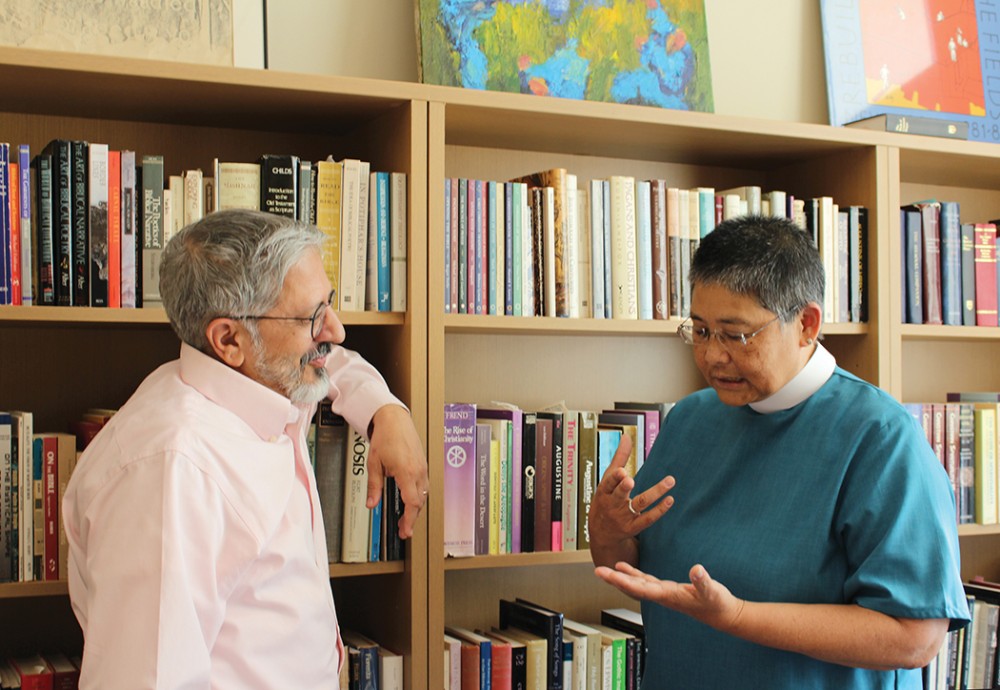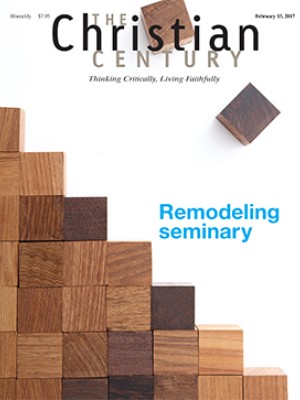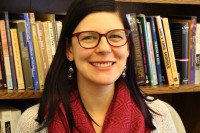Forming priests among the people
Chicago's Episcopal seminary goes all in on field education

Theological schools debate how much field education is the right amount and how to integrate practical experience into ministerial training. But what if field education were inseparable from M.Div. courses? And what if seminarians’ primary classmates were the people in the congregations they serve during their three years of seminary?
Bexley Seabury Seminary, an Episcopal school based in Chicago, has such a model in mind as it relaunches its M.Div. degree program. “At every step,” the school states, “students will be challenged to connect the content of their academic work with insights and reflections drawn from their internship experience.”
Read our latest issue or browse back issues.
KyungJa Oh, director of field education and formation, sees the advantages of keeping students rooted in the context of ministry.
“It doesn’t make sense to cloister students and give them a lot of theory and methodology and send them out,” she said. “By learning in their context, they have real-life examples, not some example the instructor cooks up.”
Part of the plan is sending faculty members to the students’ locations to teach alongside the supervising pastors, congregational governing bodies, and other parishioners who are interested. Participants from several such congregations gather for plenary sessions and apply the lessons to their own parishes and programs. Activities and assignments address real issues in those congregations.
Oh sees this approach as a way to prepare ministers for the ways the church—and the culture around it—is changing. “We want to train ordained leaders who are agile . . . who are adaptable,” she said.
Adapting to changing circumstances is something the schools that have come together as Bexley Seabury already know something about.
In 2008, Seabury-Western Theological Seminary, an Episcopal school in Evanston, Illinois, was faced with a financial crisis that caused it to suspend its M.Div. program. The school maintained its D.Min. and other programs and relocated to space in the Chicago headquarters of the Evangelical Lutheran Church in America.
Seabury also began conversations with Bexley Hall about a shared future. At the time, Bexley Hall was in a partnership with Trinity Lutheran Seminary in Columbus, Ohio.
The two Episcopal schools “avoided the word merging and used the word federating,” said Roger Ferlo, who became president of the seminaries when they officially federated in 2012 and launched a joint M.Div. program based in Columbus.
The schools created a parent organization that allows the separate corporations of Bexley Hall and Seabury-Western to continue to exist. The schools have a combined endowment of about $24 million. Part of that money came from the sale of Seabury’s property in Evanston (Bexley Hall has not owned a building since 1968). Another $2 million came to Bexley Seabury after it renewed its relationship with the Episcopal Church’s diocese in Minnesota and received monies held in a diocesan trust for theological education.
Currently, there are ten Episcopal seminaries, including Bexley Seabury. In response to its own financial crisis, the Episcopal Divinity School in Cambridge, Massachusetts, will stop granting degrees in July and is currently exploring options for how to use its resources, such as funding scholarships or becoming a center for continuing education and lay training. Bexley Seabury and EDS are working toward an agreement by which EDS’s distance-learning students could transfer to Bexley Seabury.
The Episcopal Church has seen a trend toward programs for training people for the priesthood that are not seminary-based. An example is the Bishop Kemper School for Ministry, in which the Episcopal Church’s dioceses of Kansas, Nebraska, West Missouri, and Western Kansas collaborate to educate people to be priests, deacons, and lay ministers. A drawback to such programs is that they are not accredited.
Ferlo is concerned that congregations will prefer to hire people with a seminary degree, leaving the graduates of diocesan programs at a disadvantage. “My fear is that we will have a two-tiered priesthood,” he said.
Bexley Seabury’s programs—including its new model for the M.Div. degree—are fully accredited by the Association of Theological Schools. ATS received a grant from the Lilly Endowment to support innovations among theological schools, and that helps provide funds for faculty development.
Even with accreditation and support from ATS, Ferlo and his colleagues know they are taking a chance. “These institutions are very fragile,” he said.
Yet the fragility is also a kind of strength, Ferlo said, since “we have no choice but to take risks.”
Bexley Seabury does not see itself as going after the same students who are interested in residential Episcopal seminaries. “We’re not in competition with Virginia Theological Seminary or Sewanee or Yale. We’re serving students for whom those places don’t work,” said Ferlo.
Bexley Seabury seeks students who want to enroll full-time in a program that blends online learning and contextual learning. Half of the courses Bexley Seabury students take are through Chicago Theological Seminary, which in 2013 began offering a completely online M.Div. degree.
Bexley Seabury rents office space from CTS, which built a new building in 2012 in the Woodlawn neighborhood of Chicago, near several other theological schools. The design for CTS’s new building included space for renters, said Alice Hunt, CTS president. In addition to offering Bexley Seabury students courses and the opportunity to attend daily chapel, CTS provides some administrative support.
Oh has an intuition that “teaching the M.Div. this way will address the problem of clericalism, because it’s not just ‘Father knows best.’ Everyone has experience.” The supervising priests will offer professional guidance to students, but people in the parish are likely to be teachers as well—which may lessen some of the mystique surrounding clergy. “Theological education is not just for priests anymore,” Oh said.
Supervising clergy sign up to work with a seminarian for the three years of the M.Div., beginning in the second half of the first year. The idea is that the priests at internship sites initially provide training in the tasks of ministry and move to mentoring students in those tasks in the second year. In the final year, the student functions like a curate, or assistant pastor, working on the church staff in a paid internship. (Unlike traditional curates in the Episcopal world, the students will not yet be ordained.) Bexley Seabury is still working on the funding possibilities for the internships.
Oh plans to stay in touch with the students by phone, videoconferencing, and e-mail. Supervising clergy meet with peers for their own continuing education. Oh expects that feedback from clergy, parishioners, and students will change the program as it develops. “We want to be very careful that we are not removing a rigid program and inserting another rigid program.”
More learning will come through regional gatherings of seminarians and supervising clergy. Bexley Seabury also offers intensive one-week and weekend classes.
John Addison Dally, professor of theology and culture at Bexley Seabury, is one of the faculty teaching a five-day intensive class, and he is looking at opportunities to build community outside of the class sessions. He is anticipating traveling to the students’ parishes and teaching in a way that encourages seminarians to be listeners first, rather than leaders who have all the answers.
“We want to go into the site and have everybody learn together, so they have a common reference,” he said. Dally has also been honing his skills in online teaching through live-streaming lectures.
At a time when so many seminaries are facing financial crises, said Dally, a strength of Bexley Seabury is that it has already gone through one.
“We weathered it,” he said. “You have to go through. It’s possible to come out on the other side, but you can’t do [theological education] the way you’ve been doing it.” He thinks the school’s new model will help form pastors who can in turn develop innovative, sustainable models for congregations: “We’re creating leaders to go into a situation where there might be a lack of resources, but they find the resources that are there.”
As the January term began, Bexley Seabury had a total of 12 M.Div. students. Three of them are continuing students, including Andrew Christiansen, who began his studies in Columbus and is now in his third year and doing field education in Wisconsin.
“I have hopes for Bexley Seabury in its current incarnation,” Christiansen said, noting that the incoming class at orientation, though small, was dramatically larger than the class he was part of in Ohio. He appreciates the flexibility he’s had in forming his class schedule at Bexley Seabury. During the fall semester, he took some classes online at Bexley Seabury and CTS and took other classes in person at a nearby Methodist seminary and at Nashotah House, the Episcopal seminary near Milwaukee. He thinks this ecumenical approach—and even the peripatetic aspects—will serve him well as he prepares to become a chaplain to military families.
Building deep friendships with such a pattern of education is more difficult, but not impossible, Christiansen noted. “It just takes an extra, more intentional effort.” He will miss the worship experiences and regular common meals shared with Lutheran students at Trinity Seminary in Columbus. It will be a challenge for Bexley Seabury to offer opportunities for group formation, but he has heard incoming students talk about creating community-building activities in regions where students are clustered, as well as making the most of their times in Chicago.
Ferlo, who will retire in the fall, says “there are no guarantees” of the school’s success. The candidate profile that is posted online identifies the need for the next president to raise revenue, reduce the amount drawn from the endowment, and to lessen operating deficits. But the profile also names Bexley Seabury’s move to the CTS campus and the creation of an innovative, low-residency M.Div. program as a foundation to build on. Ferlo said, “We think that this is a harbinger of the future for stand-alone seminaries.”
A version of this article appears in the February 15 print edition under the title “Forming priests among the people.”







